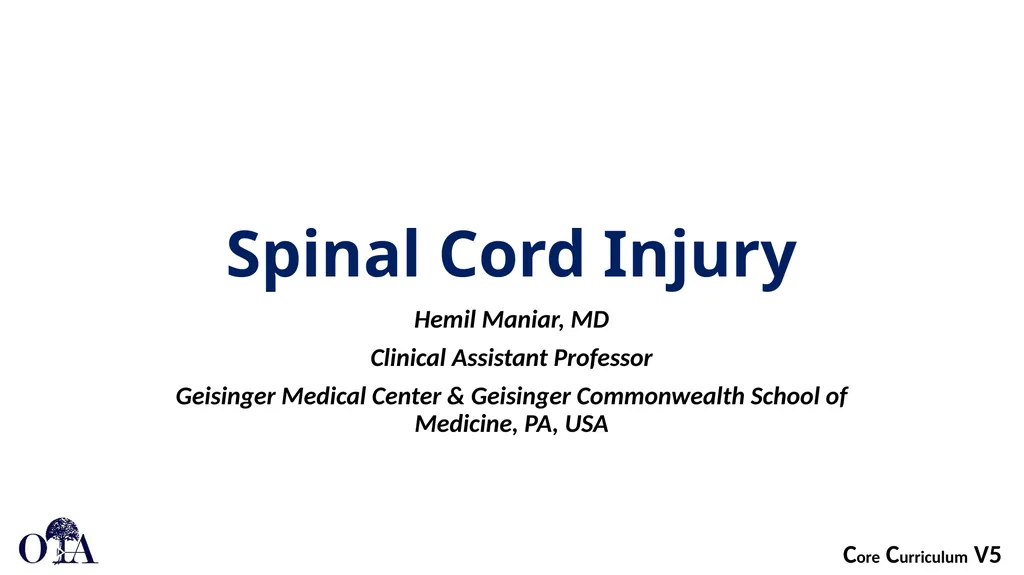Spinal Cord Injury Hemil Maniar, MD Clinical
Author : test | Published Date : 2025-05-22
Description: Spinal Cord Injury Hemil Maniar MD Clinical Assistant Professor Geisinger Medical Center Geisinger Commonwealth School of Medicine PA USA Objectives Overview of Spinal Cord Anatomy Pathophysiology of Spinal Cord Injury Classify SCIs
Presentation Embed Code
Download Presentation
Download
Presentation The PPT/PDF document
"Spinal Cord Injury Hemil Maniar, MD Clinical" is the property of its rightful owner.
Permission is granted to download and print the materials on this website for personal, non-commercial use only,
and to display it on your personal computer provided you do not modify the materials and that you retain all
copyright notices contained in the materials. By downloading content from our website, you accept the terms of
this agreement.
Transcript:Spinal Cord Injury Hemil Maniar, MD Clinical:
Spinal Cord Injury Hemil Maniar, MD Clinical Assistant Professor Geisinger Medical Center & Geisinger Commonwealth School of Medicine, PA, USA Objectives Overview of Spinal Cord Anatomy Pathophysiology of Spinal Cord Injury Classify SCIs based on neurologic involvement Identify different Spinal Cord Injury syndromes Medical and Surgical Management Rehabilitation Recent Advances Epidemiology Annual incidence rate of 15 to 40 persons per million Occurs predominantly in young, otherwise healthy individuals Male-to-female ratio for SCI is approximately 4 to 1 Causes - motor vehicle accidents (50%), falls and work-related injuries (30%), violent crime (11%), and sports-related injuries (9%) 56% of all SCI cases occur in the cervical spine. Lifetime estimated cost of medical care for a 25-year-old patient with SCI is approximately $3 million Mortality is significantly higher during the first year, is related to level, severity of injury and is influenced by availability of timely, quality medical care. Anatomy of the Spinal Cord Anatomy of the Spinal Cord Motor and descending pathways (red) Pyramidal tracts Lateral Corticospinal tract Anterior Corticospinal tract Extrapyramidal tracts Rubrospinal tract Reticulospinal tract Olivospinal tract Vestibulospinal tract Sensory and ascending pathways (green) Dorsal Column Fasciculus Gracilis Fasciculus Cuneatus Spinocerebellar tracts Posterior spinocerebellar tract Anterior spinocerebellar tract Spinothalamic tracts Lateral spinothalamic tract Anterior spinothalamic tract Anterior Posterior *C/T/L/S = Cervical/Thoracic/Lumbar/Sacral Anatomy of the Spinal Cord Pathophysiology of Spinal Cord Injury Pathophysiology of Spinal Cord Injury Biphasic – primary phase and secondary phase Primary Phase: initial impact as well as subsequent persisting compression Typically occurs with fracture dislocation, burst fractures, missile injuries, and acutely ruptured discs Secondary Phase: Primary direct cord injury then triggers a complex and delayed pathologic cascade Involves vascular dysfunction, edema, ischemia, excitotoxicity, electrolyte shifts, free radical production, inflammation, and delayed apoptotic cell death Result is cavitation of central gray matter along with partial or complete loss of adjacent white matter tracts. Mechanisms of Acute Spinal Cord Injury Primary injury mechanisms Acute compression Impact Missile Distraction Laceration Shear/Stretch Mechanisms of Acute Spinal Cord Injury Systemic Effects Bradycardia Hypotension Hypoxia Hyperthermia Local Vascular Changes Hemorrhage Loss of microcirculation Electrolyte Changes ↑sed intracellular Na+, Ca++ and K+ Biochemical changes Secondary injury Mechanisms Neurotransmitter accumulation Glutamate excitotoxicity Arachidonic acid release Free radical production Increased prostaglandins & NO Lipid peroxidation Endogenous opioids Cytokines Decrease ATP production APOPTOSIS Apoptosis process of programmed cell death affects restricted populations of spinal cord cells—including oligodendrocytes and some neuronal and astrocytic subpopulations Oligodendrocyte - plays a














